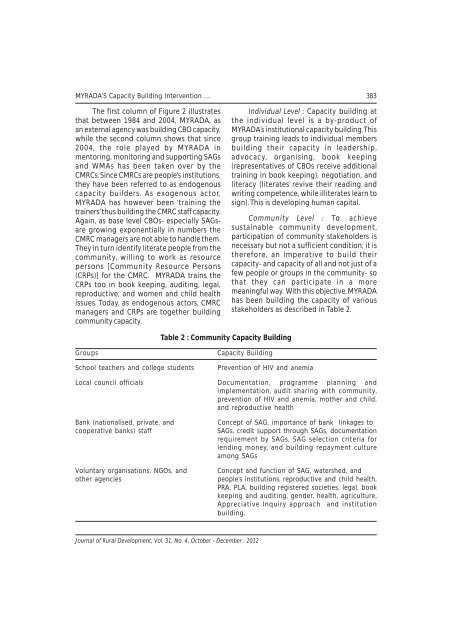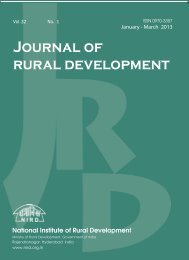MYRADA’S Capacity Building Intervention .... 383The first column <strong>of</strong> Figure 2 illustratesthat between 1984 and 2004, MYRADA, asan external agency was building CBO capacity,while the second column shows that since2004, the role played by MYRADA inmentoring, monitoring and supporting SAGsand WMAs has been taken over by theCMRCs. Since CMRCs are people’s institutions,they have been referred to as endogenouscapacity builders. As exogenous actor,MYRADA has however been ‘training thetrainers’ thus building the CMRC staff capacity.Again, as base level CBOs- especially SAGsaregrowing exponentially in numbers theCMRC managers are not able to handle them.They in turn identify literate people from thecommunity, willing to work as resourcepersons [Community Resource Persons(CRPs)] for the CMRC. MYRADA trains theCRPs too in book keeping, auditing, legal,reproductive, and women and child healthissues. Today, as endogenous actors, CMRCmanagers and CRPs are together buildingcommunity capacity.Individual Level : Capacity building atthe individual level is a by-product <strong>of</strong>MYRADA’s institutional capacity building. Thisgroup training leads to individual membersbuilding their capacity in leadership,advocacy, organising, book keeping(representatives <strong>of</strong> CBOs receive additionaltraining in book keeping), negotiation, andliteracy (literates revive their reading andwriting competence, while illiterates learn tosign). This is developing human capital.Community Level : To achievesustainable community development,participation <strong>of</strong> community stakeholders isnecessary but not a sufficient condition; it istherefore, an imperative to build theircapacity- and capacity <strong>of</strong> all and not just <strong>of</strong> afew people or groups in the community- sothat they can participate in a moremeaningful way. With this objective, MYRADAhas been building the capacity <strong>of</strong> variousstakeholders as described in Table 2.Table 2 : Community Capacity BuildingGroupsSchool teachers and college studentsCapacity BuildingPrevention <strong>of</strong> HIV and anemiaLocal council <strong>of</strong>ficials Documentation, programme planning andimplementation, audit sharing with community,prevention <strong>of</strong> HIV and anemia, mother and child,and reproductive healthBank (nationalised, private, andcooperative banks) staffVoluntary organisations, NGOs, andother agenciesConcept <strong>of</strong> SAG, importance <strong>of</strong> bank linkages toSAGs, credit support through SAGs, documentationrequirement by SAGs, SAG selection criteria forlending money, and building repayment cultureamong SAGsConcept and function <strong>of</strong> SAG, watershed, andpeople’s institutions, reproductive and child health,PRA, PLA, building registered societies, legal, bookkeeping and auditing, gender, health, agriculture,Appreciative Inquiry approach and institutionbuilding.Journal <strong>of</strong> <strong>Rural</strong> <strong>Development</strong>, Vol. 31, No. 4, <strong>October</strong> - <strong>December</strong> : <strong>2012</strong>
384 Anita Singh and T. BabuPROCESS OF CAPACITY BUILDINGMethods <strong>of</strong> Capacity Building Training :It is not the capacity building per se, but thetraining process that is empowering.Conducted in the village premises, capacitybuilders lead the CBO members throughguided dialogue, brainstorming, lecture,energizers, games, role play, and fish bowlexercise and storytelling. This processencourages the group members to interactwith each other, to decide on the problemsand solutions on their livelihood strategies.Being experiential, it makes individual andinstitutional capacity building and sustainablecommunity development a self-fulfillingprophecy. In addition, the PRA techniquewherethe trainers as well as the participantsuse instruments like sticks, stones, seeds andrangoli, i.e. coloured powders (which is easilyavailable and with which local people aremore familiar) to draw and understandconcepts-creates involved-participants, ratherthan passive-listeners. Other trainingmethods, such as interaction with a guest,field visits, and documentary shows,communicate the importance <strong>of</strong> training. Theinvited guests are <strong>of</strong>ten members <strong>of</strong> a wellfunctioningCBO who share their experienceswith the trainee group; field visits to matureCBOs, for example, to see the benefits <strong>of</strong> aparticipatory watershed programme; andvideo 14 and slide shows <strong>of</strong> capacity buildingintervention in other CBOs which facedsimilar challenges and were able to convertthem into opportunities. This method on theone hand gives exposure to participant CBOsand on the other hand ensures credibility <strong>of</strong>the outcome. In addition, sub-groupdiscussions encourage participants to discussfamily, group, and community, social andpolitical issues without fear. The confidencethat members, especially women gain is trulyempowering.Enabling an Environment : Beyondtraining, capacity building intervention is alsoabout enabling an environment whereeverybody shares best practices andinformation, and tests newly acquired skills.Jayamma and other members <strong>of</strong> ShriVidya SAG have given valuable inputs whichhave been incorporated by the schoolauthorities. Trees have been planted by themembers so that children have shade whileplaying in their school. They have contributedtowards books and uniform for children fromeven poorer families.Besides the training sessions, duringformal (SAGs and WMAs have weekly, andCBO Federations and CMRCs have monthlymeetings) and informal CBO meetings too,knowledge is created in scaled up CBOs asmembers constantly share their learning, andexperience with each other. Traditional, <strong>of</strong>tenneglected or even forgotten practices inwater and soil conservation are being revivedby ensuring the presence <strong>of</strong> at least an olderperson who communicates them. Again,through story telling, members share bestpractices, unexplored potentials, andachievements making them the common andexplicit property <strong>of</strong> all. In addition, CMRCmanagers, also keep in touch with thegovernments departments to have up-to-dateinformation (on best prices <strong>of</strong> seeds, fertilisers,crop, and about various government schemesfor the poor) which is then disseminated toother CBOs and local people. This also helpsCBOs forge external linkages and improvetheir financial transactions.Irrespective <strong>of</strong> their gender, participantsare encouraged to test, improve and practisetheir leadership, negotiation, communication,meticulous record keeping skills. In addition,nomination by rotation <strong>of</strong> a CBOrepresentative to the Federation and CMRCenhances leadership qualities <strong>of</strong> members.Moreover, nominating them six months inadvance gives them ample time to build upthe required capability and confidence thus,Journal <strong>of</strong> <strong>Rural</strong> <strong>Development</strong>, Vol. 31, No. 4, <strong>October</strong> - <strong>December</strong> : <strong>2012</strong>

















